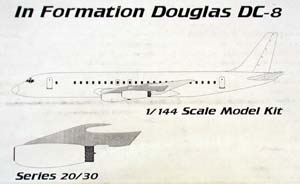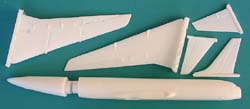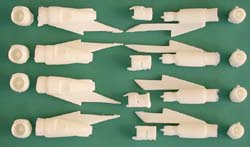In Formation's 1/144 Douglas DC-8 Series 20/30
By Chris Banyai-Riepl
 |

 |
 This is In Formation's third resin kit, and they have steadily improved their kit quality. The detail level on this kit is quite good, with recessed panel lines throughout, and fairly crisp molding as well. The fuselage is split into three pieces, with a separate nose and tailcone. The nose cone covers a hole where you can place extra weight. In addition to this, you might want to think about drilling out the fuselage to lighten the finished model, as the solid resin wings and fuselage will result in quite a bit of weight. The landing gear is to scale, which means it is delicate, and it might not be able to support the weight of the finished model over the years.
This is In Formation's third resin kit, and they have steadily improved their kit quality. The detail level on this kit is quite good, with recessed panel lines throughout, and fairly crisp molding as well. The fuselage is split into three pieces, with a separate nose and tailcone. The nose cone covers a hole where you can place extra weight. In addition to this, you might want to think about drilling out the fuselage to lighten the finished model, as the solid resin wings and fuselage will result in quite a bit of weight. The landing gear is to scale, which means it is delicate, and it might not be able to support the weight of the finished model over the years. The horizontal and vertical tails are molded separately, so you will want to be careful in aligning everything to get the proper stance. The wings are also molded separately, and as one-piece right and left halves. The engine pylons are separate, allowing the different engine types to interchange easily. There are two types of engines, both of which are well molded. Each set includes separate front sections with the fan blades molded in. Some careful research into which DC-8 you want to build is needed, but once you determine which engines you need the rest should be pretty easy. The landing gear, as I have said earlier, is quite petite and really looks the part. The main
The horizontal and vertical tails are molded separately, so you will want to be careful in aligning everything to get the proper stance. The wings are also molded separately, and as one-piece right and left halves. The engine pylons are separate, allowing the different engine types to interchange easily. There are two types of engines, both of which are well molded. Each set includes separate front sections with the fan blades molded in. Some careful research into which DC-8 you want to build is needed, but once you determine which engines you need the rest should be pretty easy. The landing gear, as I have said earlier, is quite petite and really looks the part. The main gear features separate wheel trucks, which should help you get everything sitting on all wheels. The gear doors are suitably thin as well, resulting in a very realistic looking undercarriage.
gear features separate wheel trucks, which should help you get everything sitting on all wheels. The gear doors are suitably thin as well, resulting in a very realistic looking undercarriage.